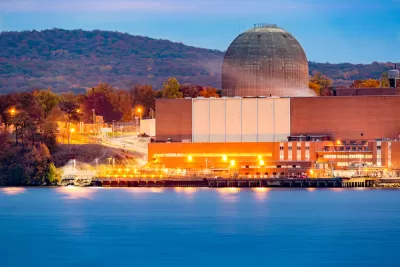Environmentalists are pushing the nuclear industry to do more to prepare for sea level rise. An estimated 13 nuclear plants in the U.S. are considered vulnerable now or in the future.

Christina Nunez writes of a threat to 13 nuclear power plants located in the United States—rising sea levels as a result of climate change. Nunez opens the story by citing the example of two reactors located off Florida's Biscayne Bay at the Turkey Point nuclear plant. The plant is licensed to operate until 2032. "At some point after that, if you believe the direst government projections, a good part of the low-lying site could be underwater," writes Nunez.
Nunez notes that the 2011disaster at Japan's Fukushima Daiichi nuclear plant shifted the debate about nuclear—especially with regard to sea level rise. Nunez cites the example of a pair of reactors in the United Kingdom that were "taken offline in 2013 because of concerns that an extreme event could overwhelm its seawall, which was then improved."
In the United States, the nuclear power industry is in the process of reevaluating its flood risks, producing a "strategy it calls FLEX, where key backup equipment is stationed at multiple locations so it can be shuttled to a distressed plant."
Given the 13 nuclear sites considered at risk, all located along the Atlantic and Gulf coasts, some believe that not enough is being done. "In the past, historical data about storms and flooding would inform the licensing requirements for a unit," explains Nunez, but sea level rise will render such historical data obsolete. Researchers have flagged four plants—in New Jersey, New Hampshire, and Connecticut—as particularly vulnerable.
The article includes more information on safety considerations at soon-to-be-decommissioned plants (such as Turkey Point, mentioned above) as well as ongoing rule-making processes that could implement additional safety regulations at nuclear plants.
FULL STORY: As Sea Levels Rise, Are Coastal Nuclear Plants Ready?

Alabama: Trump Terminates Settlements for Black Communities Harmed By Raw Sewage
Trump deemed the landmark civil rights agreement “illegal DEI and environmental justice policy.”

Planetizen Federal Action Tracker
A weekly monitor of how Trump’s orders and actions are impacting planners and planning in America.

The 120 Year Old Tiny Home Villages That Sheltered San Francisco’s Earthquake Refugees
More than a century ago, San Francisco mobilized to house thousands of residents displaced by the 1906 earthquake. Could their strategy offer a model for the present?

BLM To Rescind Public Lands Rule
The change will downgrade conservation, once again putting federal land at risk for mining and other extractive uses.

Indy Neighborhood Group Builds Temporary Multi-Use Path
Community members, aided in part by funding from the city, repurposed a vehicle lane to create a protected bike and pedestrian path for the summer season.

Congestion Pricing Drops Holland Tunnel Delays by 65 Percent
New York City’s contentious tolling program has yielded improved traffic and roughly $100 million in revenue for the MTA.
Urban Design for Planners 1: Software Tools
This six-course series explores essential urban design concepts using open source software and equips planners with the tools they need to participate fully in the urban design process.
Planning for Universal Design
Learn the tools for implementing Universal Design in planning regulations.
Clanton & Associates, Inc.
Jessamine County Fiscal Court
Institute for Housing and Urban Development Studies (IHS)
City of Grandview
Harvard GSD Executive Education
Toledo-Lucas County Plan Commissions
Salt Lake City
NYU Wagner Graduate School of Public Service




























